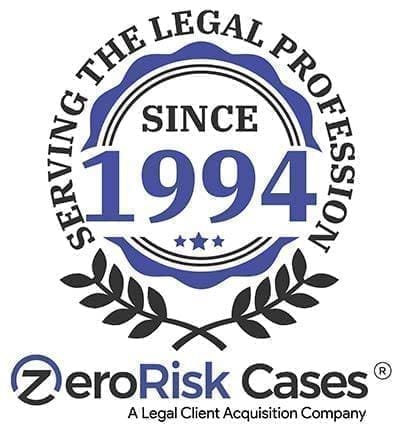MASS TORT CASES SOLD
Years Generating Mass Tort Signed Cases
Signed Cases Through Q1 2024
Cases Originated For Law Firms Since 2004

WE ARE A CLIENT ACQUISITION AGENCY
WE DELIVER READY FOR YOU PLAINTIFFS
ZeroRisk Compliance Plus Program™
ZeroRisk Mass Tort Cases™
ZeroRisk Personal Injury Cases™
How Can We Help You?
Case Acquisition Services.
Why Us?
You are looking for one thing from a case acquisition firm–> QUALITY CASES!
We just don't sell leads-we generate cases!
We Deliver Ready To Litigate Claimants. No BS!
Why Us? You are looking for one thing from a case acquisition firm–> QUALITY CASES!
We just don't sell leads-we generate cases!
We Deliver Ready To Litigate Claimants. No BS!

1
ZeroRisk Cases®
Our Zerorisk Client Acquisition Program™ and Compliance Programs are unsurpassed in quality and attention to detail when it comes to finding high-value plaintiffs for your firm. Experience Our Expertise in Mass Tort Case Generation.
Read More
2
Compliance
We are so confident in our ZeroRisk Compliance Program™, we are indemnifying our attorney clients from any lawsuit related to fake leads and lead fraud resulting from signed cases we provide under our agreement.
Read More
3
Compliance Plus
Our ZeroRisk Compliance Plus Program™ adds significant assurance and compliance to our already bulletproof ZeroRisk Compliance Program™ through Real-Time Medical Records acquisition and evaluation.
Read More
4
Signed PI Cases
ZeroRisk Cases® offers signed personal injury clients to law firms in search of claimants who’ve suffered a serious or life-threatening injury due to an accident from the fault of others. Compensible cases at a lower COA.
Read MoreWHY CHOOSE US AS YOUR
LAW FIRM MARKETING PARTNER
ZeroRisk Mass Tort Cases™
Mass Tort Cases Ready to Litigate.
What’s The Hardest Task For Your Firm? Obtaining Quality Cases, Right? Well, Not Anymore! We Provide Highly Qualified Mass Tort Clients To Your Firm.
Our ZERORISK CLIENT ACQUISITION PROGRAM™ is unsurpassed in quality and attention to detail when it comes to finding high-value plaintiffs for your firm.
Lower Your Cost Of Acquisition And Increase The Value Of Each Case With Cases That Are Obtained By Our ZeroRisk Case Acquisition Program™ And Vetted By Our ZeroRisk Compliance Program™.
Find out what our ZeroRisk Case Acquisition Program™, our PROPRIETARY lead generation technology, and our verification process are all about.
Compliance Program
ZeroRisk Cases® brings you the ZeroRisk Compliance Program™.
We indemnify our attorney clients against fake leads and lead fraud.
ZeroRisk Cases® is helping law firms maximize their chances of success with its Compliance Program.
The program helps us cut through the noise of spam and false leads and obtain actual leads that convert to higher-paying claimants.
Our team works to protect the attorney’s liability against any false claims.
We maintain the utmost transparency with the ZeroRisk Compliance ProgramTM.
Signed Personal Injury Cases
ZeroRisk Cases® is dedicated to helping lawyers grow their docket with victims injured in car accidents, slips and falls, and other personal injury accidents.
Our Signed Personal Injury Cases are unsurpassed in quality and attention to detail when it comes to finding high-value plaintiffs for your firm.
We use AI-based Behavioral Intent Targeting.
Our behavioral targeting places effective ads in front of those who are tracked doing things online consistent with someone who suffered an accident.
ALL OF OUR LEADS ARE GENERATED AND PROCESSED USING OUR ZERORISK COMPLIANCE PROGRAMTM
PI Lead Generation
All our verified leads go through a pre-qualification filtering process.
- they did not hire an attorney for this incident
- they were in an accident and sustained a bodily injury (taken to the ER or have been examined by a medical professional for their injury complaint within five days post-accident)
- they were not at fault
- the at-fault party has insurance coverage
- they describe their accident/injury and any treatment, etc.
- there is a police report available (police or other governing authority arrived at the scene of the accident)
- the date of the accident, and it is within three months
- receive medical attention WITHIN 5 DAYS OF THE ACCIDENT for any injury resulting from the accident
- they have not received any settlement for their bodily injury claim
- the VERIFIED LEAD is then processed
Why Choose Us!
We have delivered more than 2,000,000 QUALIFIED legal leads (mass tort and personal injury) in the last two years alone. We have been producing legal leads for over a decade. Our staff are U.S. based.
We are so confident in our ZeroRisk Compliance Program™ that we indemnify our attorney clients against fake leads and lead fraud.
We use cutting-edge technology that includes data mining (proprietary) and AI that, together with our vetting systems, brings you the highest quality cases at the best value. Our system is designed to deliver signed cases that have the highest value.
We developed a proprietary technology that takes data mining to the next level.
We can make your firm competitive with the largest firms in the industry.
CLIENTS REVIEW
OUR LATEST ARTICLE
Online Marketing Strategies For Law Firms
Reputation Management A great lawyer marketing service will not only focus on getting the word out about the practice; but will also aid in reputation management. Reputation management is critical on the Internet, because often, prior to deciding on a...

















